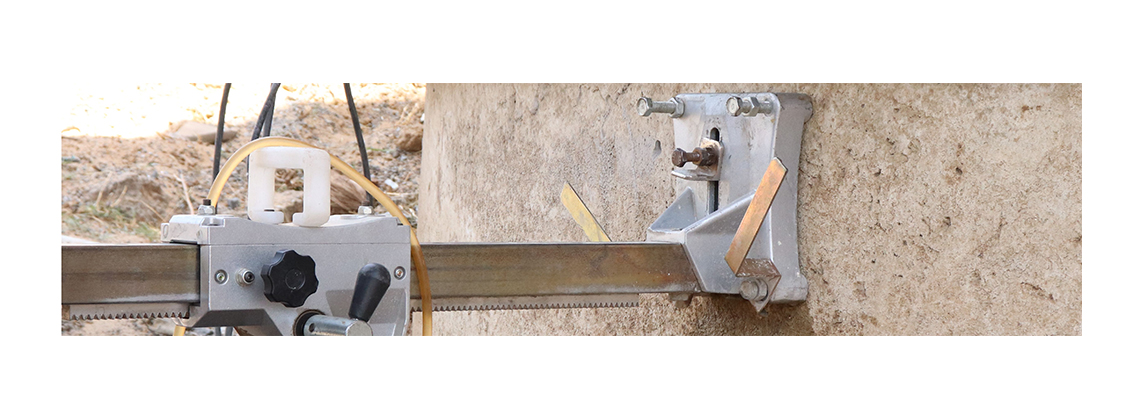What is non-destructive testing of concrete?
Posted by Certified Material Testing Products on May 05, 2023
Whether it's reinforcing a wall with steel, providing emergency repairs, or sealing hairline cracks, NDT gives us the knowledge to act, maintain and repair structures quickly and efficiently.
It helps us stop disasters before they occur, ensures the safety of the public and saves time and money for industry professionals.
But with so many different variations of NDT, it can be challenging to know which tools are right for the job.
In this article, we'll discuss why NDT is so important, its various benefits, the different types, and where you can find the best NDT tools for concrete testing.
What is non-destructive testing?
Non-destructive testing (NDT) is a method of collecting data about a material, such as concrete, without permanently damaging it.
Non-destructive testing of concrete is an excellent way to evaluate the strength of existing concrete structures without damaging them. These tests allow a structure to remain standing while an inspector checks it for strength and durability, meaning the building can remain in use while the tests are being carried out.
If defects are discovered during non-destructive tests, a structural engineer can maintain, repair, or replace affected materials on existing structures before they degrade further. Without non-destructive testing methods, there would be no way of knowing how sturdy a building is and no way to tell whether a structure requires repairs, leading to potentially devastating accidents.
Who uses NDT?
NDT is used in almost every industrial and commercial setting in America because it is an excellent way to determine whether a building is stable and secure.
Some industries have formalized NDT standards that organizations must adhere to. This is common in sectors where structural failure could be catastrophic, such as the aerospace, automotive, and nuclear industries.
In addition, concrete testing is widespread in the construction industry because it can allow the tester to find weaknesses that could compromise the safety of a structure.
Who creates legislation for NDT?
Several organizations create and enforce NDT legislation for different industries.
Each organization has its own industry rules and regulations designed to ensure that NDT is carried out correctly, effectively, and efficiently. The most common organizations that create NDT legislation in the USA include:
- ASTM (American Society for Testing and Materials)
- ASNT (American Society for Nondestructive Testing)
- ASME (American Society for Mechanical Engineers)
- API (American Petroleum Institute)
Non-destructive concrete testing: Benefits
Non-destructive testing has several key benefits over other types of testing, making it the preferred method for evaluating concrete structures.
- Accuracy and reliability: NDT techniques always provide predictable, accurate results. This is essential for quality control and to ensure the safety of the building's occupants.
- Sustainability: NDT allows defects to be detected early and without disruption, helping to extend the lifespan of structures to reduce the need for new materials and minimize waste
- Cost-effectiveness: NDT is considerably cheaper than destructive testing. The concrete can be tested where it stands without taking a sample, reducing money spent repairing or replacing damaged structures.
- Time-savings: Non-destructive methods are typically faster than destructive testing and can be performed without additional preparation or clean-up, minimizing disruptions and saving time.
- Safety benefits: Destructive concrete strength testing can be disruptive and harmful to occupants. In contrast, NDT is completely harmless and can be done risk-free to ensure the safety of everyone involved.
What is the difference between non-destructive testing and destructive testing?
In short, non-destructive testing is used to test the structural stability of a concrete surface without destroying it. Destructive testing tests stability by removing, sampling, or destroying a part of the structure.
Under most circumstances, destructive testing involves taking a small sample of a concrete structure and testing its strength and durability. The most common types of destructive testing include:
- Compression testing: This is the most common type of destructive testing used to measure the strength of concrete. It involves applying a compressive load to concrete using acompression testing machine until it fails. This is useful for determining the compressive strength of a sample to ensure it can withstand structural pressure. Before being compressed, a concrete cylinder will typically be fitted with aspecialised cap to ensure the pressure is distributed evenly.
- Flexural strength testing: This test measures the ability of concrete to resist bending. The results will indicate how well the concrete can withstand deformation.
- Splitting tensile testing: This involves creating a cylindrical sample of concrete using a concrete test cylinder and applying a compressive force along its length. The tester can then determine how resistant the concrete is to cracking under pressure.
While destructive testing usually doesn't require dismantling an entire structure, even removing a small building sample can compromise structural integrity. For this reason, NDT methods are typically the favored way of measuring a building's strength.
NDT vs. NDE vs. NDI: What's the difference?
Aside from NDT, you may also see NDI and NDE used to refer to non-destructive material testing.
- NDI - Non-Destructive Inspection
- NDE - Non-Destructive Evaluation or Non-Destructive Examination
Each of these phrases can be used interchangeably. NDT is the most commonly used initialism, but it's helpful to be aware of NDE and NDI as some inspectors may prefer these terms.
Concrete testing methods: 11 types
With so many different non-destructive concrete testing methods, knowing which is suitable for the job can be challenging. In this section, we'll look at 11 of the most common methods and why they're useful.
Ultrasonic Testing (UT)
UT involves transmitting ultrasonic pulses into a material to discover changes in the material's properties.
The most common type of UT is the ultrasonic pulse velocity test (UPV), in which an inspector times an ultrasonic pulse as it passes through a concrete structure. The faster the pulse travels through the structure, the higher the material's quality. If a pulse passes through concrete slowly, this indicates the structure is damaged and contains cracks or voids.
Equipment needed for this testing method includes a transducer and pulse generation circuit.
1.Rebound Hammer Test
The concrete rebound hammer test involves striking concrete with a spring-loaded hammer (also known as the Schmidt hammer) and measuring the rebound.
The further back the hammer rebounds, the tougher the concrete. A concrete surface with a low strength will absorb more energy from the hammer, resulting in a less pronounced rebound.
2.Penetration resistance (Windsor probe) test
The penetration resistance test involves forcefully driving a small steel probe into concrete using a controlled impact device such as the Windsor Probe. Generally, the deeper the probe penetrates the concrete, the weaker the structure. Strong, dense concrete makes it harder for the probe to penetrate deeply.
3.Electrical Resistivity Testing (ERT)
This test involves testing the electrical resistivity of concrete to detect variations in the concrete. A low-voltage electric current is injected into the concrete, and voltage is measured using two electrodes placed at a fixed distance.
Along with moisture meters, infrared thermography, and carbon depth measurement tests, electrical resistivity testing is one of the critical ways concrete testers can determine the moisture content of concrete.
4.Ground Penetrating Radar (GPR)
This method uses electromagnetic waves to detect features beneath a concrete structure. GPR is an excellent way to locate voids, delamination, and other defects that may not be visible on the concrete surface.
5.Impact-Echo Testing (IET)
The impact-echo test involves striking the surface of the concrete with a small hammer and analyzing the sound waves reflected back. This method helps measure depth and aids in locating defects and cracks that could cause structural instability.
6.Pull-out Test Method
The pull-out test measures the force needed to pull a specially shaped steel rod from the concrete from a depth of 3 inches. The force required to pull out the rod indicates the concrete's compressive strength.
7.Radiography Testing (RT)
This method uses gamma rays or X-rays to build an image of the interior of a concrete surface. RT helps uncover aspects that aren't visible during a visual inspection, such as density issues and hidden cracks.
8.Concrete crack monitoring
Crack monitoring is a simple, effective technique for assessing concrete structures for cracks. Using specialized crack monitoring tools, an inspector will locate, measure and monitor cracks to gain information about the size and extent of the damage. Cracks may be monitored using displacement transducers, tell tale gauges, calipers, or rulers.
9.Dye Penetrant Testing (PT)
Dye penetrant testing (also known as Liquid Penetrant Testing) involves using a dye to check for cracks in concrete. When the dye is applied, it will naturally fill any tiny cracks in the concrete, even if they aren't visible to the naked eye.
Note that dye testing is only helpful for detecting cracks on a concrete surface and will typically not reveal deeper structural issues, such as defects or voids.
10.Visual inspection methods
Visual inspection involves manually collecting data about concrete by looking at it. Inspectors may use a Visual Inspection tool or flashlight to reveal damages.
Visual inspection is typically a precursor to other NDT methods because it allows an inspector to determine potential problems and evaluate which testing method best suits the situation.
Where can I find tools for NDT?
Certified MTP offers a vast range of top-quality NDT tools suitable for non-destructive and destructive concrete testing.
From crack monitoring and vibration testing to concrete test hammers and slump testing devices, our selection of precise tools makes it easy to test concrete accurately, reliably, and safely.
Searching for your next reliable supplier of first-class concrete testing equipment? Browse our full range of equipment here.
If you'd like to get in touch to ask any questions or receive advice about which concrete testing method is suitable for you, contact us here. Our highly-trained, experienced technical representatives are on hand to help you find the solution to your problem.


